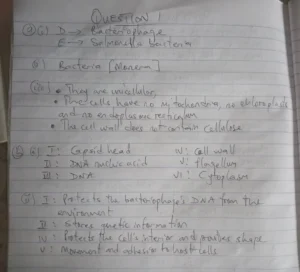2025 WAEC GCE Biology (Obj/Essay) Exam Questions and Answers –If you’re preparing for the 2025 WAEC GCE Biology (Objective & Essay) exams, this article provides all the information you need. You’ll find the WAEC GCE Biology (Objective & Essay) questions and answers for 2025, along with tips and exam details to help you succeed
We offer valuable insights for the WAEC GCE Biology (Objective & Essay) exams, making it easy to understand the format and key areas to focus on. Whether you’re looking for the 2025 WAEC GCE Biology questions and answers for the November/December exams or want to learn more about the exam format, this guide is designed to help you prepare effectively.
WAEC GCE biology Expo/Runs Questions and Answers 2025
You can also download the WAEC GCE Biology (Objective & Essay) answers for 2025 as a PDF for offline study. We’ve gathered helpful resources to assist you in understanding the questions and improving your preparation. Use this guide to enhance your study and perform at your best in the exam.

Important Dates:
The Biology Paper II & I (Essay & Objective) exams are scheduled for Wednesday, 26th November 2025, from Biology 2 (Essay): 08:30 – 10:10 hrs (1 hr 40 mins) Biology 1 (Objective): 10:10 – 11:00 hrs (50 mins).The exact timing will be confirmed by the West African Examinations Council (WAEC)
📘 Join Our WAEC Exam Room
Get live updates, likely questions, and connect with other students preparing for WAEC Mathematics GCE and other subjects.
WAEC GCE Biology (Objective & Essay) Questions and Answers 2025
The resources provided below for Biology (Objective & Essay) will help you prepare effectively for the upcoming exams. These study materials are designed to guide students toward success in the WAEC GCE.
At Iyierioba.com, we have carefully reviewed past exam performances to provide useful insights, tips, and strategies. By going through these resources, you will:
- Understand common challenges faced by candidates.
- Learn practical strategies to improve your answers.
- Gain confidence in approaching both objective and essay sections.
Using these tools will boost your comprehension, sharpen your preparation, and increase your chances of scoring high in the final exams.
WAEC GCE Biology (OBJ) Objective Answers | Nov 2025
=====================================
=====================================
WAEC GCE Biology (ESSAY) Theory Answers | Nov 2025

====================================
(b) (i)
Explain briefly the biological control of vectors.
Biological control of vectors is the use of natural enemies (such as predators, parasites, or pathogens) to reduce the population of disease-carrying organisms (vectors), thereby limiting the transmission of diseases.
(b) (ii) Give two examples of biological control of vectors.
1. Using fish (e.g., Gambusia affinis) to feed on mosquito larvae in water bodies.
2. Using the bacterium Bacillus thuringiensis israelensis (Bti) to kill mosquito larvae.
(c) State four ways of controlling the spread of pathogens in a school community.
1. Promoting regular and thorough handwashing with soap and water, especially after coughing, sneezing, or using the restroom.
2. Regular cleaning and disinfection of frequently touched surfaces (e.g., desks, doorknobs, light switches).
3. Educating students and staff on proper respiratory etiquette, such as covering coughs and sneezes with a tissue or elbow.
4. Encouraging sick students and staff to stay home to prevent transmission to others.
4. (a) (i) Explain briefly the role of mutation in evolution.
Mutations are random changes in the DNA sequence that introduce new genetic variations into a population. These new variations can lead to novel traits, some of which may provide an advantage or disadvantage in a given environment. Natural selection can then act on these variations, favoring individuals with advantageous mutations, leading to changes in allele frequencies over time and driving the process of evolution.
4. (a) (ii) Mention three evidences of evolution
1. Fossil Record : Provides a historical sequence of life forms, showing gradual changes and transitional forms over geological time.
2. Comparative Anatomy : The presence of homologous structures (e.g., the pentadactyl limb in vertebrates) suggests a common ancestry, despite different functions.
3. Molecular Biology/Genetics : Similarities in DNA sequences, proteins, and genetic codes across diverse species indicate shared ancestry and evolutionary relationships.
[ANSWERS LOADING =========================]
How to Study for WAEC Biology Second Series (Nov/Dec) GCE
WAEC GCE Biology Past Questions & Answers

BIOLOGY ESSAY ANSWERS

